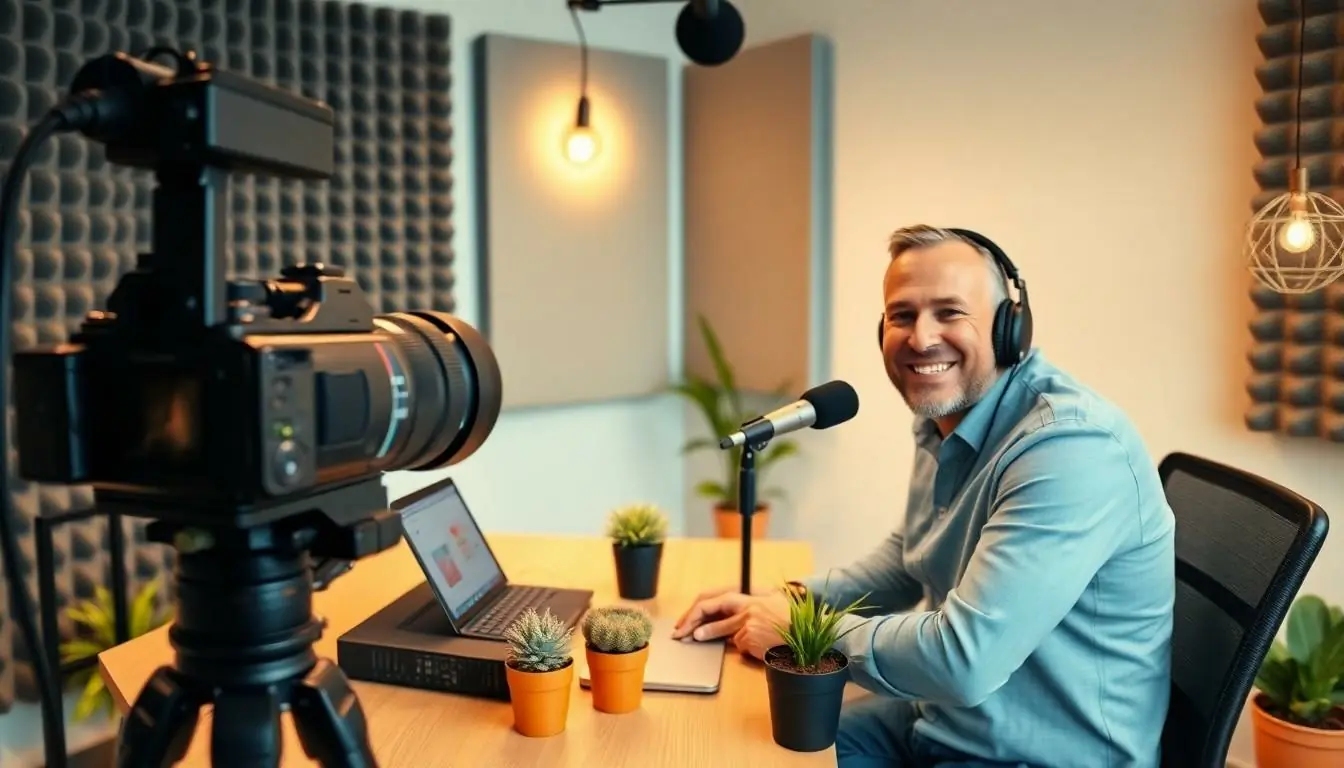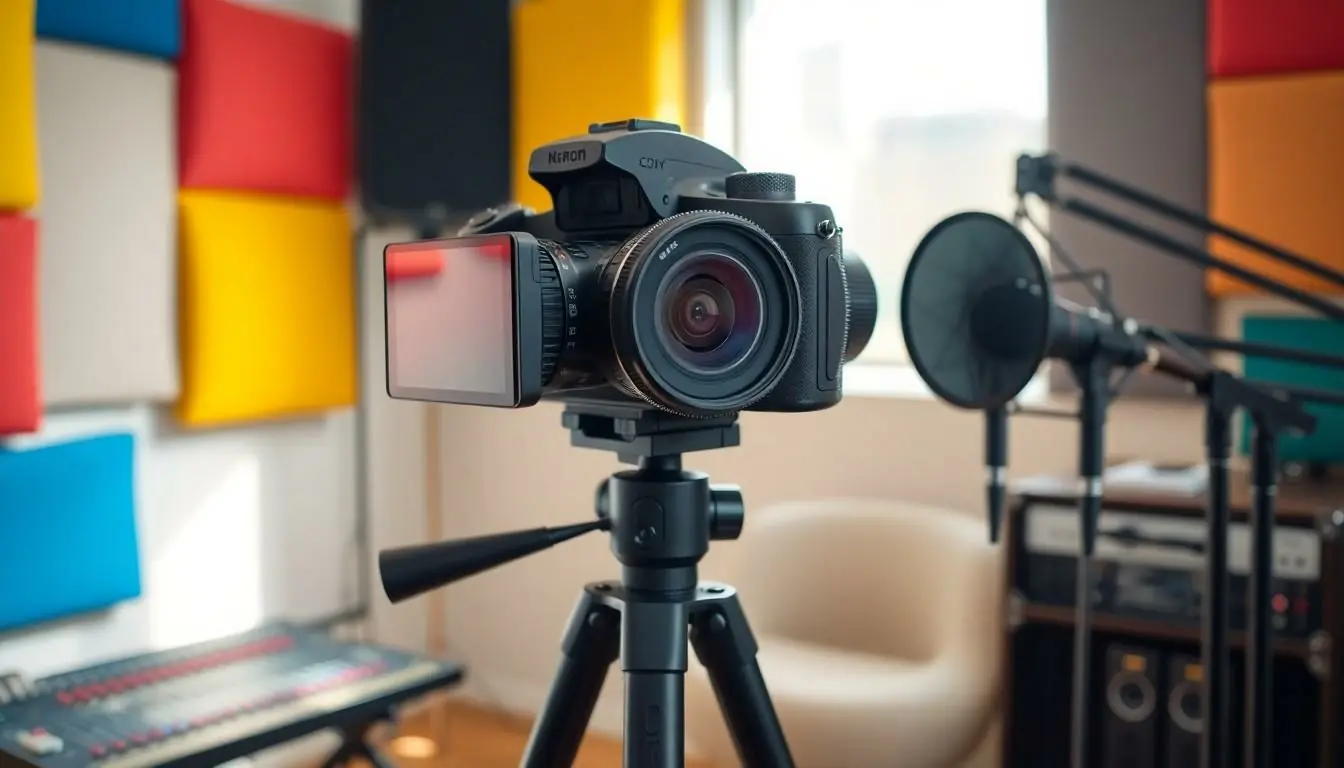Table of Contents
ToggleIn the world of podcasting, a captivating voice is just half the battle. The other half? A stellar visual experience that keeps viewers glued to their screens. Enter the podcasting camera—your secret weapon to transform your show from drab to fab. With the right gear, even the most mundane topics can shine like a diamond in a sea of coal.
Types of Podcasting Cameras
Selecting the right camera type significantly impacts a podcast’s visual quality. Different cameras offer unique advantages suited to various recording needs.
DSLR Cameras
DSLR cameras excel in providing high image quality and versatility. Photographers appreciate their ability to change lenses, allowing for different perspectives and depth of field. Many DSLRs support video recording at high resolutions, often up to 4K. These features attract podcasters who prioritize professional-grade content. Battery life remains a crucial factor, as extended recording sessions demand reliable performance. Some popular models include the Canon EOS Rebel series and Nikon D5600.
Mirrorless Cameras
Mirrorless cameras combine excellent video quality with a compact design. Their lightweight construction appeals to podcasters who need portability. Fast autofocus capabilities enhance the experience in dynamic recording environments. Many mirrorless options also support 4K video, ideal for high-definition content. Brands like Sony and Fujifilm produce popular models catering to this market. Features such as in-body stabilization further improve the recording experience, contributing to polished video output.
Webcam Options
Webcams present a user-friendly approach suitable for beginners. Many options offer decent video quality at an affordable price point, making them accessible. Easy plug-and-play functionality simplifies setup, enabling podcasters to focus on content creation. Models like the Logitech C920 or Razer Kiyo provide sharp images, often suitable for live streaming and recordings. Limited settings may restrict advanced users, but simplicity often provides an effective solution for entry-level podcasting.
Features to Consider
Choosing the right podcasting camera involves assessing several key features that impact overall performance.
Image Quality
Image quality remains a top priority when selecting a podcasting camera. High-resolution cameras, such as DSLRs, provide sharp images with excellent detail. Moreover, the sensor size influences how well a camera captures different lighting conditions. A larger sensor typically results in better color accuracy and depth, enhancing the visual appeal of content. For video-focused projects, 4K resolution is becoming standard, allowing for clearer and more engaging footage. Cameras that support interchangeable lenses offer flexibility to adapt to various filming scenarios, ensuring that visual quality matches the show’s theme and style.
Low Light Performance
Low light performance is crucial for podcasters who film in less-than-ideal lighting conditions. Cameras with larger sensors and superior ISO capabilities excel in dim environments, reducing noise and preserving image clarity. Optimal performance in low light often translates to smoother, more professional-looking footage during evening recordings or in home studios. Some cameras feature built-in stabilization, further enhancing image quality and tracking subjects easily. Evaluating low light performance ensures that the camera delivers consistent results, regardless of the recording environment.
Audio Input Options
Audio input options significantly influence sound quality in podcasting. Cameras that provide microphone inputs allow users to connect high-quality external microphones, improving overall audio clarity. XLR inputs are especially valuable for professionals who use advanced microphones, ensuring crystal clear sound. Other features, such as adjustable audio levels and monitoring options, enhance control during recording. Built-in microphones may suffice for casual use but using superior external options elevates the audio experience, making it essential to prioritize audio features when selecting a camera for podcasting.
Top Podcasting Cameras Reviewed
Choosing the right camera can significantly impact the quality of a podcast. The following cameras are among the top options for podcasters seeking to elevate their visual presentation.
Camera 1: Features and Pros
The Canon EOS R is a popular choice among podcasters. It features a 30.3MP full-frame sensor that captures stunning visuals, ensuring clarity and detail. Its 4K video capabilities offer sharp footage. Autofocus is quick and reliable, which helps maintain focus during dynamic scenes. This camera also excels in low light, making it suitable for various shooting environments. With built-in Wi-Fi and Bluetooth, sharing content becomes seamless. Podcasters appreciate this model’s versatility for both video and photo use.
Camera 2: Features and Pros
The Sony A6400 stands out for its compact design and superior video quality. This mirrorless camera comes with a 24.2MP APS-C sensor that enhances image quality. It provides 4K recording and features a flip-up screen, allowing easy monitoring during shoots. Fast and accurate autofocus helps capture every moment smoothly. Its lightweight build is ideal for podcasters who travel frequently. Additional audio input options, including a microphone jack, improve sound integration for professional setups. The combination of features makes this camera highly suitable for serious content creators.
Camera 3: Features and Pros
The Logitech C920 is an excellent option for beginners entering the podcasting realm. This webcam delivers 1080p HD video quality, striking a balance between performance and affordability. Auto-light correction ensures adequate exposure, even in lower lighting conditions. Plug-and-play functionality simplifies the setup process, making it user-friendly. Integrated stereo audio with dual microphones enhances sound quality without needing additional equipment. Many new podcasters find its simplicity appealing while still offering decent quality for engaging video content.
Tips for Using a Podcasting Camera
Proper use of a podcasting camera enhances visual engagement. Following specific tips can significantly improve the overall production quality.
Setting Up the Camera
Positioning the camera at eye level creates a strong connection with viewers. Ensure the background aligns with the podcast’s theme. Use a tripod to maintain stability and avoid shaky footage. Verify that the camera settings match the lighting conditions to achieve the best image quality. Utilize the camera’s autofocus features instead of manual adjustments for consistent clarity. Test different angles before recording to find the most flattering perspective. Evaluate the framing of the shot, ensuring the subject is centered and adequately highlighted.
Best Angles and Lighting
Experimenting with different angles can elevate visual interest. Using a 45-degree angle from the subject generally provides a flattering view. Good lighting plays a crucial role in video quality. Soft, diffused light minimizes harsh shadows and provides a warmer tone to the visuals. Positioning lights in front of the subject eliminates backlighting, making the image clearer. Consider using natural light from windows or investing in softbox lights for controlled illumination. Evaluate the scene regularly to maintain a visually appealing setup throughout the recording.
Conclusion
Investing in the right podcasting camera can significantly elevate a show’s visual appeal and overall quality. By understanding the unique advantages of various camera types and key features to prioritize, podcasters can select equipment that aligns with their goals. Whether opting for a high-end DSLR or a beginner-friendly webcam, the right choice can transform ordinary content into something captivating.
With thoughtful camera positioning and lighting, creators can enhance viewer engagement and create a professional atmosphere. As the podcasting landscape continues to grow, leveraging visual elements will be essential for standing out and connecting with audiences.





